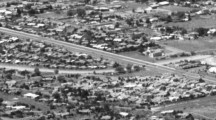Abstract
We deal with the problem of landmine field detection using low-resolution infrared (IR) image sequences measured from airborne or vehicle-borne passive IR cameras. The proposed scheme contains two parts: a) employ a multi-scale detector, i.e., a special type of isotropic bandpass filters, to detect landmine candidates in each frame; b) enhance landmine detection through seeking maximum consensus of corresponding landmine candidates over image frames. Experiments were conducted on several IR image sequences measured from airborne and vehicle-borne cameras, where some results are included. As shown in our experiments, the landmine signatures have been significantly enhanced using the proposed scheme, and automatic detection results are reasonably good. These methods can therefore be applied to assisting humanitarian demining work for landmine field detection.
Preview
Unable to display preview. Download preview PDF.
Similar content being viewed by others
References
Earp, S., Hughes, E., Elkins, T., Vickers, R.: Ultra-wideband ground-penetrating radar for the detection of buried metallic mines. IEEE Aerospace and Electronics System Magazine 11(9), 14–17 (1996)
Filippis, A., Jain, L., Martin, N.: Using generic algorithms and neural networks for surface land mine detection. IEEE Trans. Signal Processing 27, 176–186 (1999)
Paik, J., Lee, C.P., Abidi, M.: Image processing-based mine detection techniques: a review. Subsurface Sensing Technologies & Applications 3(3), 153–202 (2002)
Faust, A.A., Chesney, R.H., Das, Y., McFee, J.E., Russell, K.L.: Canadian teleoperated landmine detection systems. Part I: The improved landmine detection project. Part II: Antipersonnel landmine detection. Int’l Journal of Systems Science 36(19), 511–543 (2005)
Sahli, H., Bruschini, C., Crabble, S.: Catalogue of advanced technologies and systems for humantarian demining. EUDEM 2 Technology Report, Dept. Electron. Inf., Vrij Univ. Brussel, Belgium, v.1.3 (2006)
Gu, I.Y.H., Tjahjadi, T.: Detecting and locating landmine fields from vehicle- and air-borne measured IR images. Pattern Recognition 35, 3001–3014 (2002)
Gu, I.Y.H., Tjahjadi, T.: Multiresolution feature detection using a family of isotropic bandpass filters. IEEE Trans. SMC (part B) 32(4), 443–454 (2002)
Lundberg, M., Gu, I.Y.H.: A 3D matched filter for detection of land mines based on spatio-temporal thermal model. In: Proc. SPIE Conf. Detection and Remediation Technologies for Mines and Minelike Targets V. SPIE, vol. 4038(I), pp. 179–188 (2000)
Lundberg, M., Gu, I.Y.H.: Infrared detetion of buried land mines based on texture modeling. In: Proc. of SPIE conf. Detection and Remediation Technologies for Mines and Minelike Targets VI. SPIE, vol. 4394, part one, pp. 275–283 (2001)
Lu, W.S., Antoniou, A.: Two-dimensional digital filters. Marcel Dekker, Inc., New York (1992)
Lowe, D.G.: Distinctive image features from scale-invariant keypoints. IJCV 20, 91–110 (2004)
Fischler, M.A., Bolles, R.C.: Random sample consensus: a paradigm for model fitting with applications to image analysis and automated cartography. Commun. of the ACM 24, 381–395 (1981)
Khan, Z.H., Gu, I.Y.H., Wang, T., Backhouse, A.: Joint anisotropic mean shift and consensus point feature correspondences for object tracking in video. In: IEEE Int’l conf. Multimedia & Expo. ICME 2009 (2009)
Wang, T., Gu, I.Y.H., Khan, Z.H., Shi, P.: Adaptive particle filters for visual object tracking using joint PCA appearance model and consensus point correspondences. In: IEEE Int’l conf. Multimedia & Expo., ICME (2009)
Author information
Authors and Affiliations
Editor information
Editors and Affiliations
Rights and permissions
Copyright information
© 2009 Springer-Verlag Berlin Heidelberg
About this paper
Cite this paper
Wang, T., Gu, I.YH., Tjahjadi, T. (2009). Enhanced Landmine Detection from Low Resolution IR Image Sequences. In: Jiang, X., Petkov, N. (eds) Computer Analysis of Images and Patterns. CAIP 2009. Lecture Notes in Computer Science, vol 5702. Springer, Berlin, Heidelberg. https://doi.org/10.1007/978-3-642-03767-2_150
Download citation
DOI: https://doi.org/10.1007/978-3-642-03767-2_150
Publisher Name: Springer, Berlin, Heidelberg
Print ISBN: 978-3-642-03766-5
Online ISBN: 978-3-642-03767-2
eBook Packages: Computer ScienceComputer Science (R0)




